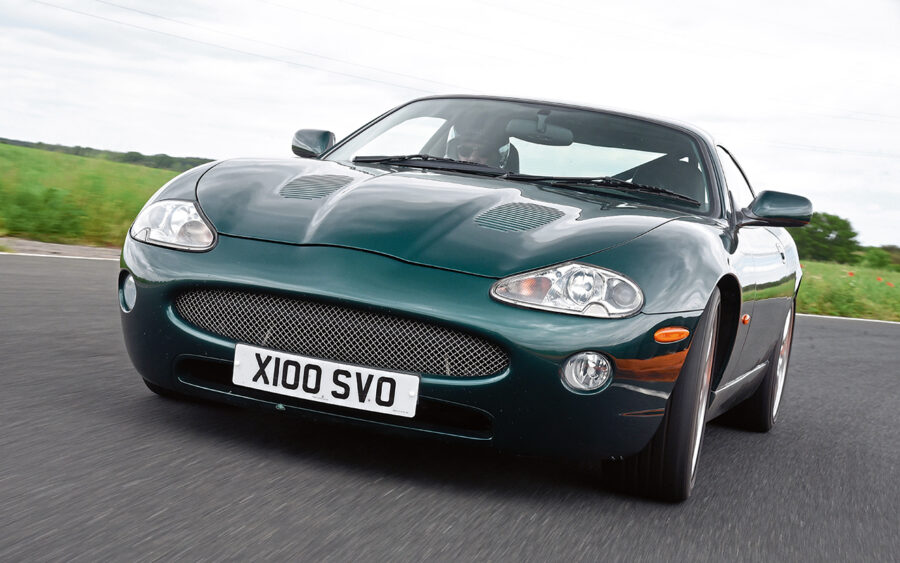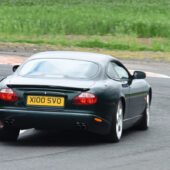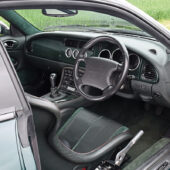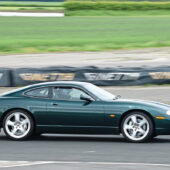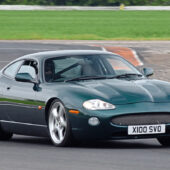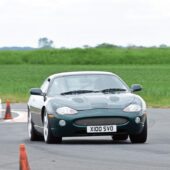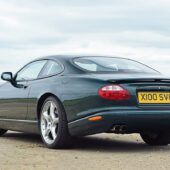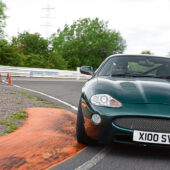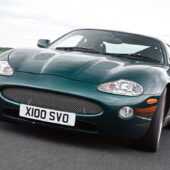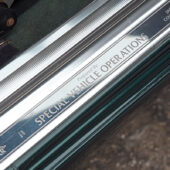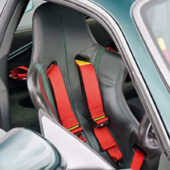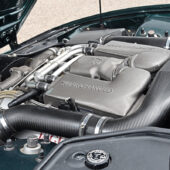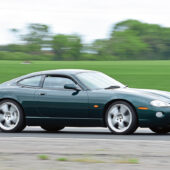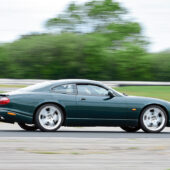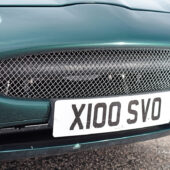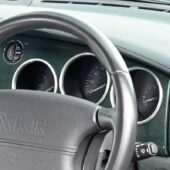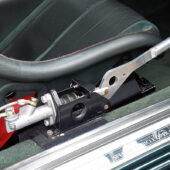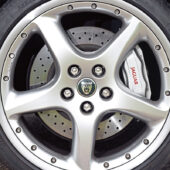With 400bhp, a manual gearbox and stiffer suspension, the Jaguar XKR-R is a hardcore coupe that never made production
Words and images: Paul Walton With thanks to: Jaguar Heritage Trust, JEC Racing
As I exit The Ump, a fast but tricky chicane to get right, I bury the throttle. Hard. Being in second gear, the 4.0-litre supercharged engine responds instantly, rewarding me with a sudden rush of acceleration.
I nervously keep my foot down entering the longer left-hand Lancaster corner, changing up to third as I do. I can feel the back end wanting to break away in spite of the fat tyres finding grip on the smooth asphalt, but I keep my foot planted as the corner unwinds and I enter a short straight. Here, I change up to fourth. At this speed, the next series of corners – a fast left-right chicane – arrive quickly, but I don’t back off; every time I’d been around previously I’d only managed between 90mph and 95mph, but now I am determined to reach the magic ton.
The cabin fills with the deep roar of the V8. Keeping my nerve and accelerating, I rush past the first braking board, followed almost instantly by the second. At the third, I snatch a glimpse of the speedo and see – thankfully – the needle pointing to 100mph. I stamp on the pedal, the big discs slowing me down sufficiently to throw the car into the chicane. The XKR leans more than a heavy ship in a storm, but it makes it. With another even longer straight coming, I bury the throttle again, pushing the lever up to third.
An exhilarating experience. If you didn’t know, you might be surprised to learn I’m driving an XKR 4.0 coupe. Although fast, they traditionally lack the responsiveness to make them proper sports cars, although that’s exactly what Jaguar’s Special Vehicle Operations (SVO) did in 2000 to this XKR-R. It transformed the car into a pure performance machine, with 400bhp, a five-speed manual gearbox and beefed-up suspension, all without damaging the XKR’s grand tourer image.
In the early 2000s, Ford was keen on making Jaguar Britain’s answer to Porsche, with a range of high-performance cars that were credible rivals to those that Stuttgart was producing, and with an image to match. It started this process by buying the Stewart F1 team in 1999 and renaming it Jaguar. Next, it tasked the Browns Lane-based SVO department to develop a car that could become a test bed for potential future performance parts.

SVO was no stranger to developing special cars. Responsible for several of Jaguar’s previous concepts (including the beautiful X300-based Daimler Corsica convertible in 1996 and bonkers XK 180 two years later) the team was used to pushing the boundaries of what was possible. The model chosen was the XKR 4.0-litre coupe.
Mike Massey, SVO’s development manager, explained about the project in 2001, “From our earliest days under company founder Sir William Lyons, Jaguar cars have always been about the excitement of driving.”
This time, it wasn’t a simple case of modifying an existing car, but building one from the ground up using new, modified and custom-built parts. Not a single component escaped the team’s attention in the metamorphosis into what was later known as the XKR-R.
SVO began by strengthening the shell of an X100-generation XKR and seam-welding the unibody. To enhance rigidity, a front suspension crossbeam was mounted to the underbody using aluminum bushings, rather than the standard rubber items. Finally, an eight-point roll-bar was installed in place of the rear seats.
The rear suspension was greatly altered, and featured custom Eibach springs with fully adjustable racing-type remote-reservoir shock absorbers specific to the vehicle, reducing the car ride height 30mm below standard. It used the same style of SVO-designed steering rack as the XK 180 concept, which gave a fast 2.2 turns lock-to-lock. Stopping power came courtesy of Jaguar’s Brembo-sourced R-Performance brake calipers and cross-drilled rotors.
In perhaps the biggest change, SVO fitted an entire rear floor area from the S-Type, along with the saloon’s rear axle. “Use of the S-Type axle allowed us a greater range of adjustment and tuning, keeping in mind the dual personality of the car,” explains Massey.
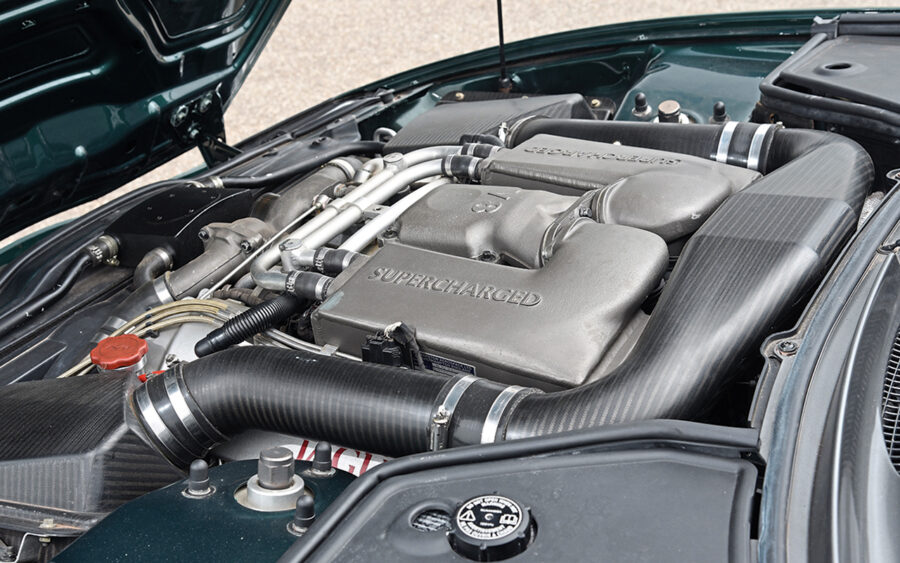
With twin carbon fibre air intakes, enlarged intercoolers and an increased supercharger, the power output of the 4.0-litre V8 increased from 370bhp to 400bhp, plus the same amount of torque. And, for the first time in the XKR’s history, the car was fitted with a customised Tremec T-56 six-speed manual unit (resembling that found in the Dodge Viper and Chevrolet Corvette) instead of the standard five-speed Mercedes-Benz automatic gearbox. Paired with an AP Racing twin-plate clutch, the transmission was considered able to handle the XKR-R’s power and torque. Design-wise, the R-R differs from a standard model by its revised front bumper and by wearing its own 20in BBS-sourced R-Performance wheels.
The result is a car with a unique and mouth-watering specification and a menacing appearance. “The XKR-R Performance Prototype was produced to show just how far we could go with the basic XKR architecture, with the addition of a few modifications,” continues Massey. “We aimed to build a road car – comfortable, easy to live with and very drivable – that could acquit itself with the very best track cars. I think we’ve succeeded.”
SVO produced a pair of cars: a rough and ready development hack – registered X701 KRW – and a better-finished display model, X100 SVO, that also featured a small rear spoiler. As with most of SVO’s previous prototypes, both were fully finished, drivable machines.
In 2001, Jaguar allowed the press to sample the development hack. Declared Autocar in its 20 June 2001 issue, “It’s not quick in the [Mitsubishi] Evo ‘jump up and bite for two seconds then change a gear’ sense. It’s much more heroic than that.
“For the first half-a-second there’s a light pause, a moment of hesitation while the Kraken wipes the sleep from its eyes. Then, it just takes off.”
Then there was praise from presenter and former F1 driver Tiff Needell as he put the car in a powerslide during a 2001 episode of BBC Top Gear: “This is the Jaguar of my dreams. The standard cars, with their soft suspension and automatic ’boxes, are too tame for me. This is my kind of animal.”
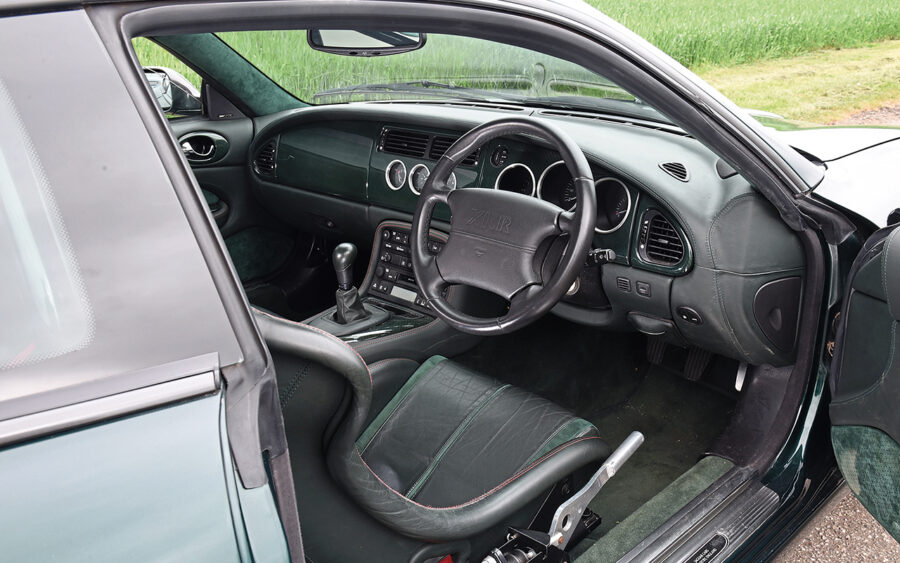
In November 2001, SVO 100X was on display at Las Vegas’ influential Specialty Equipment Market Association (SEMA). There, it whet the appetite of everyone who saw it for what Jaguar might do next.
And that was… nothing. Whether it was the cost of further development or, more likely, the prototypes were too similar to the harder, more driver-focused DB7 GT produced by sister company Aston Martin, the XKR-R – and the parts that made it special – were never taken forward. Following an appearance of SVO 100X in a 2003 episode of Top Gear, when it was compared to the Aston, the project was quietly forgotten. To this day, the R-R is rarely mentioned and is barely a footnote in the history of the X100 generation of XK.
Thankfully, at least one example still exists as a reminder of what could have been. Although the whereabouts of X701 KRM are unknown – the DVLA’s website says it hasn’t been taxed since 2003 so it has potentially been destroyed – the show car was gifted to the Jaguar Daimler Heritage Trust, where it could be preserved and protected.
Until, that is, I request to give it a track test. The location for my drive is Lincolnshire’s Blyton Park, a tight, twisting, yet fast circuit a few miles from Gainsborough. It is, as with most British circuits, a former WW2 RAF base – RAF Blyton – and the views have changed little since its war days. Flat or featureless or not, it’s still the ideal place to test a one-of-a-kind supercar.
When Jaguar Heritage’s Steve Kinnell backs the XKR-R out of its covered trailer, I’m more excited than the time I met rally legend Stig Blomqvist. With available space in the Trust’s excellent Collection Centre, in Gaydon, at a premium, the big coupe is rarely displayed and I can’t remember the last time – if ever – I saw it.
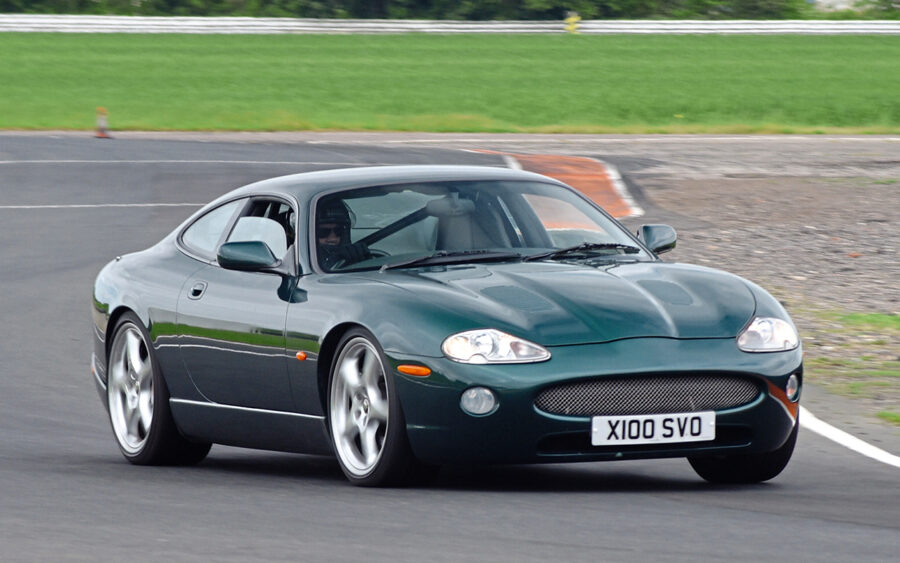
This isn’t a car to disappoint, looking resplendent in Racing Green. Its lowered suspension, which allows the huge wheels to properly fill the arches, the simple full-width mesh grille and the absence of a nose badge give the car an angrier, more muscular appearance than a standard R, yet the X100’s beautiful and graceful lines remain.
The interior was mainly all new for the time, but gave glimpses of what was to come. The veneer, for example, is green carbon fibre, a preview of the limited-edition XKR Carbon Fibre of 2004, while the chrome rings around the dials are identical to those of the very last 4.2-S models from 2005. A roll cage takes the place of the rear bench, and tight, restrictive buckets – complete with four-point racing harnesses, while still beautifully trimmed in leather and suede – replace the usually wide and comfortable front seats. Like a club bouncer wearing a hand-made Italian silk suit, it’s still a luxurious cabin, but one that clearly means business.
Another difference is the hydraulic handbrake, no doubt fitted to make it easier to slide, but which won’t allow the car to pass an MOT test – hence why I’m at Blyton. Yet, these aren’t the most noticeable differences. What really sets the car apart from a standard model is the tall, manual gearlever and the red engine cut-off switch located just behind the centre console.
Helmet on, harness clicked into place, I turn the key and the 4.0 V8 erupts into life with a roar. After putting the ’box into first and starting to slowly move toward Blyton’s track entrance, the small info screen in the speedo begins to continuously flash GEARBOX FAULT and INCORRECT PART FITTED. Nothing to worry about, just the result of SVO not changing the car’s ECU to recognise the manual transmission. As the circuit’s red light turns green and I squeeze the throttle for the first time, I hope to god the second one doesn’t mean me.
Holy smokes this thing is fast. With my internal organs being squeezed backwards, acceleration is instant, hard and uncompromising and just keeps coming. Jaguar estimated that the R-R could reach 60mph in a mere 4.5 seconds, a similar time to the 5.0-litre F-Type P450, but it feels much more exciting than that.

Derestricted, the XKR-R can also reach 180mph, not that I’ll be doing that today. I change up to second and then third in quick succession, the Tremec ’box, while being accurate, sadly lacking the short, sharp, throws of a genuine competition ’box. What really impresses me is the delivery of the endless power, the V8 being the smoothest and most eager to rev of any 4.0-litre I’ve ever driven. It’s refined, too. While the deep, gravelly note is no doubt louder than a standard car’s, the sports exhaust that SVO fitted lacks the ridiculous over-the-top theatrics of, for example, an F-Type 5.0 R.
After negotiating The Ump, Lancaster and the perfectly named Wiggle Chicane, I floor it for another straight, the big car screaming out of the corner like a jet thundering off an aircraft carrier. The car again picks up a frightening pace, but, thankfully, the big Brembo brakes do a remarkable job of smoothly scrubbing off speed for the next tight left corner, Bishops, and then another, the fabulously named Bunga Bunga. If only F1 circuits had names like this, it would make Martin Brundle’s commentary even more exciting.
Next up is the trickiest part of the track: a fast right-left chicane – Port Froid – followed by a tight right corner, Ushers. The brakes, steering and gearbox might all be up the to job, but the car’s weight prohibits it from being a pure sports car. Although at 1,690kg (Autocar’s figure) it is around 30kg less than a standard XKR coupe, it’s still very heavy – leaving me heaving it through the bends in a bear-wrestling style. The traction control warning light also flashes, as it does out of most corners, the system fighting the car’s natural instinct to kick its tail out. A braver man would turn it off and have some rear action fun but, always aware of the car’s importance and, even more importantly, the fact that it’s not mine, I leave well alone.

After changing down to second to get through Ushers, I keep the ’box in the low gear for the following straight ready for the final corner, Twickers. Exiting perfectly allows me to carry huge amounts of speed and I again change up to third then fourth as I speed towards the first corner, a fast left-hand bend called Jochen, which feeds into The Ump. In reality, the engine has so much torque I could complete an entire lap in fourth or even fifth and still set a quick time. But, then, SVO might as well have stuck to the automatic.
Over the next few laps I begin to really understand what an amazing machine this is. Fast and easy to drive, but with a hardness lacking from the standard car. If SVO had managed to shave off another 200kg – which would have been easy to do; those racing seats are still electrically operated and there’s even air conditioning – it would have turned the coupe into an even more responsive sports car.
Although it’s a pity the project never went any further, the idea behind it clearly lived on, because the XKR-S GT, from 2013, is very much a direct descendent of the XKR-R. What I like most about the car is that, for all the extra speed, it’s still a perfectly built, cleverly designed and well-thought-out car, all of which help to retain the XK’s famed refinement yet make it much more exciting. Despite what the XKR-R says, there isn’t an incorrect part anywhere on it.

